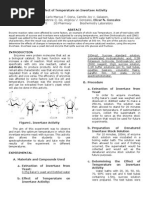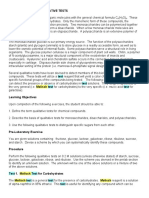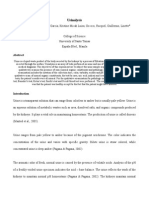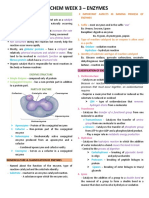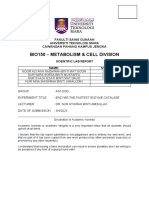Enzyme Lab Report Final
Uploaded by
rsenser2Enzyme Lab Report Final
Uploaded by
rsenser2Laboratory Exercise 6: Enzyme Activity Name: Richard Senser Section: BIO111607 Date Performed: 6/15/11 Professor: Judith Boyle
Date Report Written: 10:45:02
Name of Lab Partner(s): Shannon Lee
Introduction A number of chemical reactions continue their processes due to the factors of time or an extra input of energy, usually in the form of heat, being added to the reactants of any chemical reaction. If one was to rely on the factor of time, the chemical reaction could require mere nanoseconds or millions of years to complete on its chemical process. The implication of energy in the form of heat could vary as well, from the heat produced by ones body to that produced from the death of a near by star. These reactions can be speeded up, so to speak, or made to react/proceed at a lower energy input, by the addition of a catalyst to the reactants. The formal definition of a catalyst is described in paragraph one, line four, of page one of the Laboratory Exercise 6: Enzyme Activity lab manual. To define a catalyst in words more easily understood, a catalyst lowers the energy of activation, EA, of a reaction, i.e. the energy needed to start the reaction; thus allowing the reaction to occur at a faster rate. So what is an enzyme? An enzyme is a protein-based, biocatalyst or an organic catalyst. These biocatalysts are specific to a certain chemical reaction within an organism, such as metabolism. The challenge with metabolism is many of the reactions needed, need to be performed very rapidly and at a low enough temperature so that the reaction will occur and prevent the killing of the organism. This is where enzymes, our biocatalysts, come in. The biocatalysts will lower the EA , thus allowing the necessary reactions within the metabolic process to occur at a lower energy input; making them occur faster and at an optimal temperature to protect they reaction, but, most importantly, the organism from killing itself. Being a protein-based catalyst allows one to understand the reasoning behind the specificity of these biocatalysts. The underlying structure and formation of a protein gives us the answer. Once the protein has formed into its three-dimensional shape or its native conformation, it will only catalyze a specific reaction. This phanominon is due to the active site, a site located on the three-dimensional structure of the enzyme, which matches the shape of the target reactant aka the substrate. When an enzyme is placed into the reactants of a specific chemical reaction, the enzyme-specific reactant or substrate binds to the active site of the enzyme, which activates it; allowing it to lower the EA and speeding up the overall reaction. Like Superman's weakness to kryptonite, everything has a point or substance that renders then ineffective. In biological terminology an enzyme that is rendered ineffective is know as denaturation, the process of a permanent change in or destruction of the enzymes three-dimensional shape. Enzymes can be denatured by either chemical or environmental factors. For example, if an enzyme is placed into a solution with a pH or temperature that differs from its optimal pH or temperature significantly, it will result in denaturation of the enzyme and leave it ineffective. In our experiment we tested the affect of differing levels of pH, i.e. 2, 7, 14 and differing temperatures, i.e. 2C, 40C, 80C on the amount of O2 produced, in milliliters, over a period of ten minutes, in thirty second intervals, from the enzymatically driven reaction of hydrogen peroxide to water and oxygen: 2H2O2 2H2O + O2 The reason as to why we are measuring the amount of oxygen produced is to see if the pH and/or temperature of the solution in which the enzyme is placed will have an affect the enzyme by either slowing the rate of the reaction or causing denaturation. If the amount of oxygen produced is little to none, we know the enzyme has been denatured. If the amount of oxygen produced is high, then we know the enzyme is working within this optimal environment. We will also be examining the rate at which the oxygen is produced; the same principles are in effect. If the rate is high, the reaction is proceeding at a rapid pace, alluding to an optimal environment. If the rate of oxygen production is slow to stagnant, the reaction is not proceeding and this result alludes to a less than optimal or denaturing environment. My two hypothesesfor this experiment is as follows: 1
A. If the catalase is placed into a solution in which the temperature differs significantly, as in an extreme of 5C or more, from 37C, a normal body temperature; then the rate of the enzymatically-driven breakdown of hydrogen peroxide by catalase will be affected by causing the enzyme to denature; thus rendering it ineffective and stopping/slowing the rate of O2 produced. B. If catalase is placed into a solution that is at a pH level which differs significantly, as in an extreme of 0.50 on the pH scale or more, from the bodys pH range of 7.35 7.45; then the rate of the enzymatically-driven breakdown of hydrogen peroxide by catalase will be affected by causing the enzyme to denature; thus rendering it ineffective and slowing/stopping the rate of O2 produced. Materials and Methods My lab partner was Shannon Lee and we were testing the affects of adding catalase to the enzymatically-driven breakdown of hydrogen peroxide at three differing levels of pH, 2, 7 and 12. The pH level of 2 is highly acidic and mainly found within vinegar, the pH level of 7 is neural or that of water and the pH level of 12 is highly basic and mainly found in household ammonia. The amounts of O2 produced from the enzymatically-driven reaction were recorded within the table 1 and 2 and are displayed within the Results section. The set up of this experiment and a list of all the material can be found on pages two and three, as well as on part C of page 5 of the lab manual. The set up involved the preparation of the hydrogen peroxide solution, 5 millilitersof hydrogen peroxide along with 4 millilitersof catalase and 2 milliliters of distilled water, a 50milliliter graduated cylinder a reaction chamber and a tub filled with 4 inches of water. The water was set at 37C, an optimal temperature for this metabolic reaction, and the set up for this experiment can be seen on page 4 of the lab manual. Results Below are both the tables and graphs from the above experiment: Enzyme Reaction at Differing pH Levels Time (Min) pH2 (ml) pH7 (ml) pH 12 (ml) 0.00 0.00 0.00 0.00 0.50 0.00 13.00 0.00 1.00 0.50 20.00 1.00 1.50 1.00 26.00 1.00 2.00 1.00 34.00 1.00 2.50 1.00 39.00 1.00 3.00 1.00 43.00 1.00 3.50 1.00 46.00 1.00 4.00 1.00 47.00 1.00 4.50 1.00 49.00 1.00 5.00 1.00 50.00 1.00 5.50 1.00 52.00 1.00 6.00 1.00 52.00 1.00 6.50 1.00 53.00 1.00 7.00 1.00 53.00 1.00 7.50 1.00 53.00 1.00 8.00 1.00 53.00 1.00 8.50 1.00 53.00 1.00 9.00 1.00 53.00 1.00 9.50 1.00 53.00 1.00 10.00 1.00 53.00 1.00 2
pH of 2 pH of 7 pH of 12 pH of 2 pH of 7 pH of 12 pH of 2 pH of 7 pH of 12 pH of 2 pH of 7 pH of 12 Table 2 and Graph 2:
0.059740 26 4.158441 558 0.049350 649 1.00 53.00 1.00 1:30 6:30 1:00 1.00 53.00 1.00
Average rate of 0.06 mls of O2 produced every 30 seconds. Average rate of 4.16 mls of 02 produced every 30 seconds. Average rate of 0.05 mls of O2 produced every 30 seconds. Max rate of milliliters of O2 produced over ten minutes. Max rate of milliliters of O2 produced over ten minutes. Max rate of milliliters of O2 produced over ten minutes. Time at which milliliters of O2 produced leveled off. Time at which milliliters of O2 produced leveled off. Time at which milliliters of O2 produced leveled off. Total amount of milliliters of O2 produced over ten minutes. Total amount of milliliters of O2 produced over ten minutes. Total amount of milliliters of O2 produced over ten minutes.
Enzyme Reaction at Differing Temperatures Time (Min) 2C 40C 80C 0.00 0.00 2.00 0.00 0.50 1.00 4.00 0.50 1.00 1.00 4.50 0.50 1.50 1.50 5.00 0.50 2.00 1.50 10.00 0.50 2.50 1.50 12.00 0.50 3.00 2.00 13.00 0.50 3.50 2.00 14.00 0.50 4.00 2.50 15.00 0.50 4.50 3.00 15.00 0.50 5.00 3.00 16.00 0.50 5.50 3.00 17.00 0.50 6.00 4.00 17.00 0.50 6.50 4.00 17.50 0.50 7.00 4.00 18.00 0.50 7.50 4.50 18.50 0.50 8.00 4.50 19.00 0.50 8.50 4.50 19.00 0.50 9.00 4.50 19.50 0.50 9.50 4.50 20.00 0.50 10.00 4.50 20.00 0.50
2C 40C 80C 2C 40C 80C 2C 40C 80C
0.455844 156 1.727272 727 0.012987 013 4.50 20.00 0.50 7:30 9:30 0:30
Average rate of 0.46 mls of O2 produced every 30 seconds. Average rate of 1.73 mls of O2 produced every 30 seconds. Average rate of 0.13 mls of O2 produced every 30 seconds. Max rate of milliliters of O2 produced over ten minutes. Max rate of milliliters of O2 produced over ten minutes. Max rate of milliliters of O2 produced over ten minutes.
Time at which milliliters of O2 produced leveled off. Time at which milliliters of O2 produced leveled off. Time at which milliliters of O2 produced leveled off. Total amount of milliliters of O2 produced over ten 2C 4.50 minutes. Total amount of milliliters of O2 produced over ten 40C 20.00 minutes. Total amount of milliliters of O2 produced over ten 80C 0.50 minutes. Discussion The purpose of this of our experiment was to test the affect of differing levels of pH, i.e. 2, 7, 14 and differing temperatures, i.e. 2C, 40C, 80C on the amount of O2 produced, in milliliters, over a period of ten minutes, in two minute intervals, from the enzymatically driven reaction of hydrogen peroxide to water and oxygen: 2H2O2 2H2O + O2 The reason as to why we are measuring the amount of oxygen produced is to see if the pH and/or temperature of the solution in which the enzyme is placedwill affect the enzyme by either slowing the rate of the reaction or causing denaturation. My two formal hypotheses for this experiment were as follows: A. If the catalase is placed into a solution in which the temperature differs significantly, as in an extreme of 5C or more, from 37C, a normal body temperature; then the rate of the enzymatically-driven breakdown of hydrogen peroxide by catalase will be affected by causing the enzyme to denature; thus rendering it ineffective and stopping/slowing the rate of O2 produced. B. If catalase is placed into a solution that is at a pH level which differs significantly, as in an extreme of 0.50 on the pH scale or more, from the bodys pH range of 7.35 7.45; then the rate of the enzymatically-driven breakdown of hydrogen peroxide by catalase will be affected by causing the enzyme to denature; thus rendering it ineffective and slowing/stopping the rate of O2 produced. The above hypotheses are accepted in my opinion. The reasoning behind this would is displayed within the table and graph. When looking at the affect of temperature on an enzymatic reaction, we see that at a temperature of 2C and a temperature of 80C, both differing with an extreme of 5C from 37C, the enzyme was denatured and rendered ineffective. This can be seen by both the low level of O2 produced and the slowed to stagnant rate of O2 produced these temperatures. When all three values are compared, it is both visually apparent and supported by the data that the optimal temperature at which this particular enzyme can produce the most amount of O2 and work at its fullest poetical,is at a temperature 4
of 40C; thus supporting hypothesis A. As with hypothesis A, hypothesis B is supported as well. One can visually verify the support of hypothesis B by glancing within the table and graph. When looking at the affect of pH on an enzymatic reaction, we see that at a pH of 2 and a pH of 12, both differing with an extreme of 0.5 on the pH scale from the bodys pH range of 7.35 7.45, the enzyme was denatured and rendered ineffective. This can be seen by both the low level of O2 produced and the slowed rate of O2 produced at both pH levels of 2 and 12. When all three values are compared, it is both visually apparent and supported by the data that the optimal level of pH at which this particular enzyme can produce the most amount of O2 is at a pH of 7; thus supporting hypothesis B. Discussion Questions: 1. What do the rate of oxygen production and/or the amounts of oxygen tell us about the chemical reaction? a. The oxygen production and/or the amount of oxygen tell is if the enzyme is working within an optimal environment. If the amount of oxygen produced is little to none, we know the enzyme has been denatured. If the amount of oxygen produced is high, then we know the enzyme is working within this optimal environment. 2. Given the conditions tested, which are the best for catalase activity? a. A pH of 7 and a temperature of 40C, which is not surprising seeing as this reaction occurs within many organisms and the above levels known as near standard. 3. How does the 80C treatment affect catalase? What experimental data supports your answer? a. At a temperature of 80C, we can see that the average rate of O2 produced is 0.01 mils every 30 seconds and the time at which the reaction leveled off was after 30 seconds. This tells us that at this temperature, the enzyme cannot function, at first the substrate binds to the active site but then the temperature is too high and the overall three-dimensional structure falls apart, or denatures. This all happened within the span of 30 seconds and then the amounts of O2 produced levels off; alluding to the inactivity of the present enzyme. For without catalase, there is not reaction. 4. How does the 40C treatment affect catalase? What experimental data supports your answer? a. At a temperature of 40C, we can see that the average rate of O2 produced is 1.73 mils every 30 seconds and the time at which the reaction leveled off was after 9 minutes and 30 seconds. This tells us that at this temperature, the enzyme is in an optimal environment, at first the substrate binds to the active site and the enzyme continues to proceed with the reaction until there all the substrate has been used up. This happened within the span of 9 minutes and 30 seconds and then the amounts of O2 produced levels off alluding to the depletion of the substrate within the solution. For without the presence of a substrate, there is nothing to bind to the active site, and so the enzyme will shut off. 5. How do various pH treatments affect the catalase? What experimental data supports your answer? a. By looking at data, one can visually verify the affect of pH on an enzymatic reaction; we see that at a pH of 2, the average rate of O2 produced was 0.06 mils every 30 seconds and the time at which the production leveled off was after 1 minute and 30 seconds. With a pH of 12, we see that the average rate of O2 produced was 0.05 mils every 30 seconds and the time at which the production leveled off was after 1 minute. Both values differ with an extreme of 0.5 or more on the pH scale from the bodys pH range of 7.35 7.45, this enzyme was denatured and rendered ineffective due to the extremeenvironmental factors i.e. extreme basic and acidic nature of the solutions. To put it simply, these environments are simply too acidic and basic for the enzyme to function properly and resulted in a slowed or stagnant rate of O2 production. 6. Why does the production of oxygen slow down over time? a. The enzyme is using up the substrate within the solution, thus the reaction slows and the rate of O2 produced slows as well. The substrate is like gas and the enzyme is like the car, if the car has little to no gas, it cannot function properly nor can it accelerate or continue to drive down the road. 5
7. If you added more catalase to the 37C reaction that had stopped producing oxygen, what do you expect would happen? a. Nothing. If you add more catalase to a solution that has no substrate, then the catalase that is added will remain inactive, due to the lack of substrate binding to the active site. 8. If you added more hydrogen peroxide to the 37C reaction that had stopped producing oxygen, what do you expect would happen? a. The reaction would continue. This is due to the addition of the substrate. If the reaction has stopped producing O2 this means that there is not substrate left within the solution to bind to the active site and activate the enzyme. If more substrate is added, it will bind to the active site of the enzyme and allowing the enzyme to proceed with the break down of hydrogen peroxide to water and oxygen; thus the production of oxygen would continue. Though my both my hypotheses were supported, my lab partner and I came across some errors. For the readings within the pH of 12, we noticed that the amount of O2 produced was far from those of other classmates. After further investigation, we noticed that during the trial run, the airtight seal and rubber hose were not fixed into the 50 mil-graduated cylinder. It was due this fact that our values for this trial were skewed. Based on this experiment and the data collected one is able to conclude that the optimal environment in which this specificcatalase is able to function is around 40C and in a pH around 7. This type of environment allows the enzyme to function at its fullest potential and produce the maximum amount of product allotted by the implemented amount of substrate present without the hindrance of environmental factors.
You might also like
- Module 7 & 8: Carbohydrates: Name: Group No.: 6No ratings yetModule 7 & 8: Carbohydrates: Name: Group No.: 610 pages
- Kami Export - Lab 8 Enzymes Answer SheetNo ratings yetKami Export - Lab 8 Enzymes Answer Sheet3 pages
- Enzymes and PH - The Effect of PH On The Activity of The Enzyme Catalase100% (1)Enzymes and PH - The Effect of PH On The Activity of The Enzyme Catalase1 page
- Effect of Temperature On Invertase Activity100% (3)Effect of Temperature On Invertase Activity3 pages
- EXPT 2 LAB REPORT Extraction and Characterization of Proteins Group 2No ratings yetEXPT 2 LAB REPORT Extraction and Characterization of Proteins Group 211 pages
- Name: Kristine Joy Atos Block: BSN 1-D Practice Problems100% (3)Name: Kristine Joy Atos Block: BSN 1-D Practice Problems6 pages
- Week 2 Practical - Chemistry of Carbohydrates100% (1)Week 2 Practical - Chemistry of Carbohydrates7 pages
- Experiment Title: Millon's Test ObjectiveNo ratings yetExperiment Title: Millon's Test Objective2 pages
- Act 3 Factors Affecting Enzyme Activity PH and Inhibitors PDFNo ratings yetAct 3 Factors Affecting Enzyme Activity PH and Inhibitors PDF3 pages
- Experiment-6 and 7 Biochemistry LaboratoryNo ratings yetExperiment-6 and 7 Biochemistry Laboratory6 pages
- Exp. 3 Test For The Presence of Carbohydrates Molisch Test100% (2)Exp. 3 Test For The Presence of Carbohydrates Molisch Test4 pages
- Jhfdsxavier University Ateneo de Cagayan: Salivary Digestion (Laboratory Report No. 11)No ratings yetJhfdsxavier University Ateneo de Cagayan: Salivary Digestion (Laboratory Report No. 11)11 pages
- Biochemistry: What Can I Do With This Major?No ratings yetBiochemistry: What Can I Do With This Major?3 pages
- Research Scientist Pharmaceuticals Biotech in Gaithersburg MD Resume Arundhati GhoshNo ratings yetResearch Scientist Pharmaceuticals Biotech in Gaithersburg MD Resume Arundhati Ghosh3 pages
- Pengantar Anatomi Gigi, Teriminologi, & NomenklaturNo ratings yetPengantar Anatomi Gigi, Teriminologi, & Nomenklatur19 pages
- Total Maxillectomy and Orbital ExenterationNo ratings yetTotal Maxillectomy and Orbital Exenteration18 pages
- Complete Dentures: The Role of Occlusion in Preservation and Prevention in Complete Denture Prosthodontics100% (1)Complete Dentures: The Role of Occlusion in Preservation and Prevention in Complete Denture Prosthodontics18 pages
- Human Neuropsychology 2nd Edition G. Neil Martin - The full ebook version is just one click away100% (1)Human Neuropsychology 2nd Edition G. Neil Martin - The full ebook version is just one click away59 pages
- Phyllomedusa: Skin: A Huge Factory and Store-House of A Variety of Active PeptidesNo ratings yetPhyllomedusa: Skin: A Huge Factory and Store-House of A Variety of Active Peptides6 pages
- Biopharmaceutics and Pharmacokinetics: S. Lakshmana Prabu, T.N.K. Suriyaprakash, K. Ruckmani and R. ThirumuruganNo ratings yetBiopharmaceutics and Pharmacokinetics: S. Lakshmana Prabu, T.N.K. Suriyaprakash, K. Ruckmani and R. Thirumurugan20 pages
- Amino Acid Biosynthesis and DegradationNo ratings yetAmino Acid Biosynthesis and Degradation11 pages
- Enzymes and PH - The Effect of PH On The Activity of The Enzyme CatalaseEnzymes and PH - The Effect of PH On The Activity of The Enzyme Catalase
- EXPT 2 LAB REPORT Extraction and Characterization of Proteins Group 2EXPT 2 LAB REPORT Extraction and Characterization of Proteins Group 2
- Name: Kristine Joy Atos Block: BSN 1-D Practice ProblemsName: Kristine Joy Atos Block: BSN 1-D Practice Problems
- Act 3 Factors Affecting Enzyme Activity PH and Inhibitors PDFAct 3 Factors Affecting Enzyme Activity PH and Inhibitors PDF
- Exp. 3 Test For The Presence of Carbohydrates Molisch TestExp. 3 Test For The Presence of Carbohydrates Molisch Test
- Jhfdsxavier University Ateneo de Cagayan: Salivary Digestion (Laboratory Report No. 11)Jhfdsxavier University Ateneo de Cagayan: Salivary Digestion (Laboratory Report No. 11)
- Research Scientist Pharmaceuticals Biotech in Gaithersburg MD Resume Arundhati GhoshResearch Scientist Pharmaceuticals Biotech in Gaithersburg MD Resume Arundhati Ghosh
- Pengantar Anatomi Gigi, Teriminologi, & NomenklaturPengantar Anatomi Gigi, Teriminologi, & Nomenklatur
- Complete Dentures: The Role of Occlusion in Preservation and Prevention in Complete Denture ProsthodonticsComplete Dentures: The Role of Occlusion in Preservation and Prevention in Complete Denture Prosthodontics
- Human Neuropsychology 2nd Edition G. Neil Martin - The full ebook version is just one click awayHuman Neuropsychology 2nd Edition G. Neil Martin - The full ebook version is just one click away
- Phyllomedusa: Skin: A Huge Factory and Store-House of A Variety of Active PeptidesPhyllomedusa: Skin: A Huge Factory and Store-House of A Variety of Active Peptides
- Biopharmaceutics and Pharmacokinetics: S. Lakshmana Prabu, T.N.K. Suriyaprakash, K. Ruckmani and R. ThirumuruganBiopharmaceutics and Pharmacokinetics: S. Lakshmana Prabu, T.N.K. Suriyaprakash, K. Ruckmani and R. Thirumurugan















